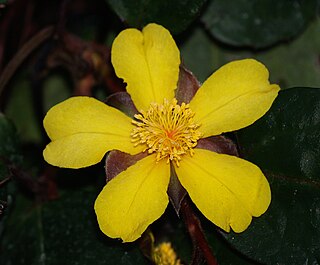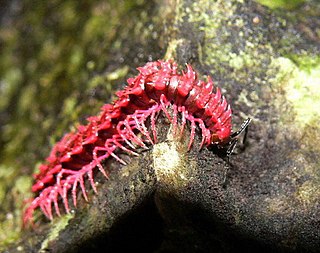Related Research Articles

Curtisia dentata is a flowering tree from Southern Africa. It is the sole species in genus Curtisia, which was originally classed as a type of "dogwood" (Cornaceae), but is now placed in its own unique family Curtisiaceae.

Roridula is a genus of evergreen, insect-trapping shrubs, with two species, of about 1⅓–2 m. It is the only genus in the family Roridulaceae. It has thin, woody, shyly branching, upright, initially brown, later grey stems, with lance- to awl-shaped leaves crowded at their tips. The star-symmetrical flowers consist from the outside in of five, green or reddish, free sepals, alternating with five white, pink or purple, free petals. Further to the middle and opposite the sepals are five stamens with the anthers initially kinked down. These suddenly flip up if the nectar-containing swelling at its base is being touched. The center of the flower is occupied by a superior ovary. The leaves and sepals carry many sticky tentacles of different sizes, that trap insects. Roridula does not break down the insect proteins, but bugs of the genus Pameridea prey on the trapped insects. These later deposit their feces on the leaves, which take up nutrients from the droppings. The species can be found in the Western Cape province of South Africa. They are commonly known as dewstick or fly bush in English and vlieëbos or vlieëbossie in Afrikaans.

The Asian leaf turtle is a species of turtle found in Southeast Asia. They are quite common in the pet trade; their carapaces resemble that of a Cuora amboinensis hybrid.
Wilhelm Moritz Keferstein was a German naturalist. He described a number of reptiles and amphibians for the first time.

Banksia dentata, commonly known as the tropical banksia, is a species of tree in the genus Banksia. It occurs across northern Australia, southern New Guinea and the Aru Islands. Growing as a gnarled tree to 7 m (23 ft) high, it has large green leaves up to 22 cm (8.7 in) long with dentate (toothed) margins. The cylindrical yellow inflorescences, up to 13 cm (5.1 in) high, appear between November and May, attracting various species of honeyeaters, sunbirds, the sugar glider and a variety of insects. Flowers fall off the ageing spikes, which swell and develop follicles containing up to two viable seeds each.

Hibbertia dentata, commonly known as toothed guinea flower, trailing guinea flower or twining guinea flower, is an ornamental plant in the family Dilleniaceae native to the east coast of Australia. Found in woodland, it is a trailing or twining vine with leaves with several small 'teeth' on the margins and bright yellow flowers in early spring. It adapts readily to cultivation and can be grown as a pot plant. The species was first described in 1817.
Nectomys grandis, also known as the Magdalena-Cauca water rat, is a nocturnal, semiaquatic species of rodent in the genus Nectomys of family Cricetidae. It is found in western and northern Colombia at altitudes from sea level to 2000 m, including the basins of the Magdalena, Cauca and Porce rivers. It has two subspecies, N. g. grandis and N. g. magdalenae.

Desmoxytes, whose species are commonly known as the dragon millipedes, is a genus of millipedes of the family Paradoxosomatidae found in Southeast Asia. The genus was described by Ralph Vary Chamberlin in 1923, and reviewed by Sergei Golovatch and Henrik Enghoff in 1994. At least 18 species are known from to Malaysia, Myanmar, and Thailand. One species, D. planata, has also been observed in Sri Lanka, the Andaman Islands, Seychelles, Java, Great Coco Island, and Fiji; however, this species has expanded its range by being transported through human activity. Several species have only recently been discovered, and some have yet to be officially described.

Polydesmida is the largest order of millipedes, containing approximately 3,500 species, including all the millipedes reported to produce hydrogen cyanide (HCN). Polydesmids grow and develop through a series of moults, adding segments until they reach a fixed number in the adult stage, which is usually the same for a given sex in a given species, at which point the moulting and the addition of segments and legs stop. This mode of development, known as teloanamorphosis, distinguishes this order from most other orders of millipedes, which usually continue to moult as adults, developing through either euanamorphosis or hemianamorphosis.
Hylomus is a genus of millipede of the family Paradoxosomatidae found in southeast Asia.

Cyclemys is a genus of freshwater turtles, commonly referred to as Asian leaf turtles, from the family Geoemydidae. The genus occurs throughout Southeast and South Asia, and currently contains seven species.

Paradoxosomatidae, the only family in the suborder Paradoxosomatidea, is a family of flat-backed millipedes in the order Polydesmida. Containing nearly 200 genera and 975 species as of 2013, it is one of the largest families of millipedes. Paradoxosomatids occur on all continents except Antarctica, and can generally be distinguished by dorsal grooves on most body segments and a dumb-bell shaped gonopod aperture. Notable groups within the Paradoxosomatidae include the dragon millipedes of Southeast Asia, and the widely introduced greenhouse millipede Oxidus gracilis.

Piabucus is a genus of freshwater tetras in the family Iguanodectidae. All three species are found in South America, largely the Amazon and its major tributaries. None of them are longer than half a foot long, with the largest reaching a maximum size of 12.9 cm (5.1 in), and they are slender, with relatively deep chests and long pectoral fins. Their scales are pale or silvery, with lateral lines that stand out.
Antichiropus is a genus of millipede in the family Paradoxosomatidae. The genus is very distinctive in the form of the gonopod, which is typically coiled through at least a full circle. It is probably endemic to Australia. Some species have small ranges of less than 10000 km2, classifying them as short-range endemic invertebrates.

Casimir Albrecht Willem Jeekel (1922–2010) was a Dutch myriapodologist and entomologist known for his major contributions to the taxonomy of millipedes. His 1971 monograph Nomenclator Generum et Familiarum Diplopodorum is credited as launching the "modern era" of millipede taxonomy, and has been considered the "most important single work ever published on the Diplopoda". He served as director of the Zoological Museum Amsterdam, and authored over 150 works on the taxonomy of millipedes and other myriapods.
Hylomus rhinoceros is an aposematic species of dragon millipede in the family Paradoxosomatidae. It is only known from Champasak and Sekong Provinces in southern Laos.

Chamberlinius is a genus of flat-backed millipedes in the family Paradoxosomatidae. There are five species; 3 of which occur only Taiwan, one only in the Ryukyu Islands of southeast Japan, and one occurring in both areas. Individuals are 25–37 mm (0.98–1.46 in) long and up to 5.5 mm wide, colored in pale yellow to brown, sometimes with dark brown markings on the anterior portion of body segments.
Anoplodesmus luctuosus is a species of millipedes in the family Paradoxosomatidae. It is endemic to Sri Lanka, which was first documented from Ramboda. The species sometimes placed in the genus Polydesmus of the family Polydesmidae.

Anoplodesmus is a genus of millipedes. It is one of the most species rich genera in the family Paradoxosomatidae, with over 40 described species distributed from India and Nepal to China and Southeast Asia, as well as the Mascarene Islands and Fiji.
References
- ↑ Nguyen, A. D. & Sierwald, P. (2013). "A worldwide catalog of the family Paradoxosomatidae Daday, 1889 (Diplopoda: Polydesmida)". CheckList. 9 (6): 1132–1353. doi: 10.15560/9.6.1132 .